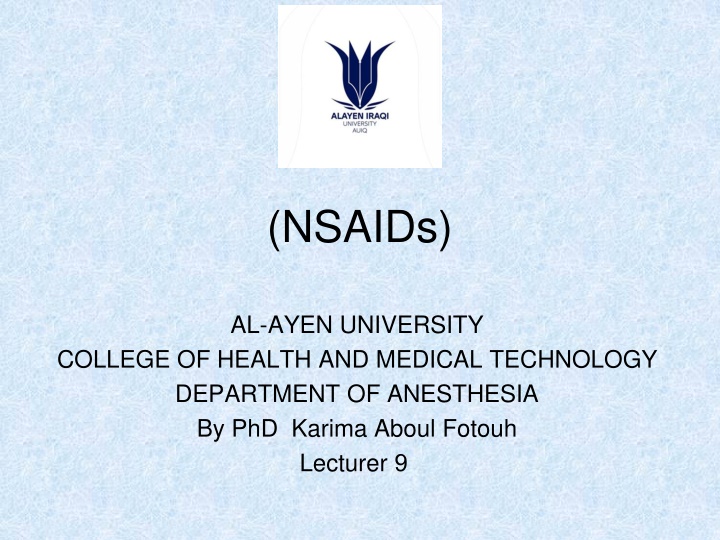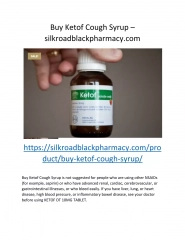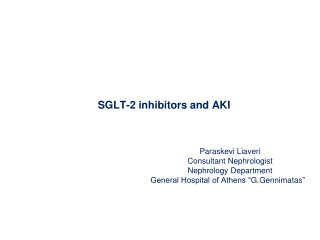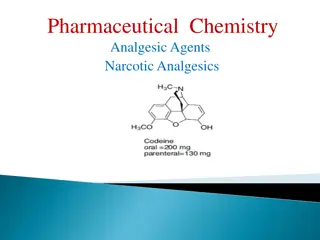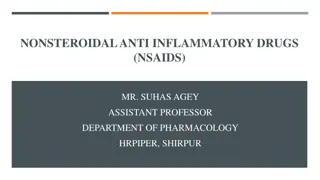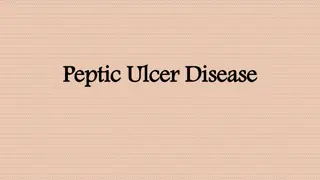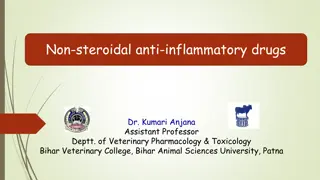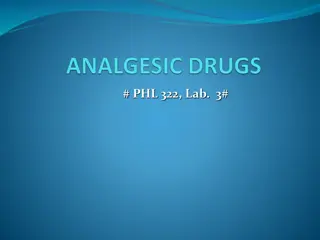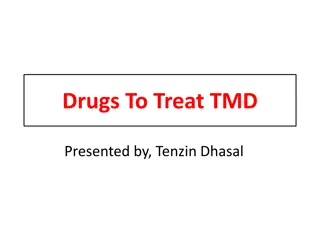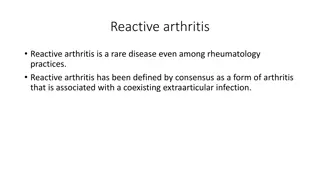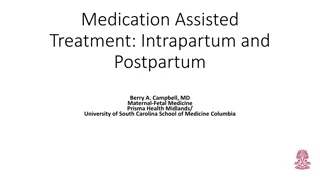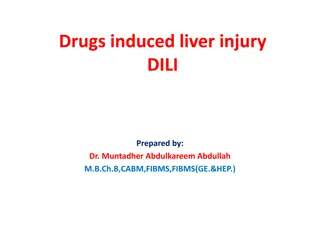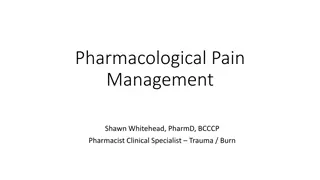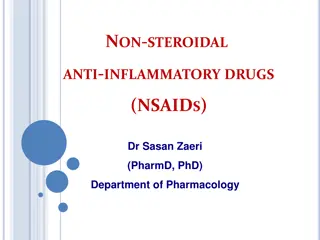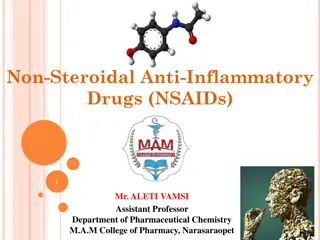(NSAIDs)
Non-Steroidal Anti-inflammatory Drugs (NSAIDs) inhibit prostaglandin synthesis via cyclo-oxygenase (COX) enzyme. They have analgesic, antipyretic, and anti-inflammatory effects. This group includes Salicylates, Indol derivatives, Propionic acid derivatives, and more. Salicylates have local antifungal and systemic CNS actions. NSAIDs also have anti-inflammatory and antirheumatic properties by inhibiting COX enzymes. Respiratory and acid/base balance effects are observed with NSAIDs.
Download Presentation

Please find below an Image/Link to download the presentation.
The content on the website is provided AS IS for your information and personal use only. It may not be sold, licensed, or shared on other websites without obtaining consent from the author.If you encounter any issues during the download, it is possible that the publisher has removed the file from their server.
You are allowed to download the files provided on this website for personal or commercial use, subject to the condition that they are used lawfully. All files are the property of their respective owners.
The content on the website is provided AS IS for your information and personal use only. It may not be sold, licensed, or shared on other websites without obtaining consent from the author.
E N D
Presentation Transcript
(NSAIDs) AL-AYEN UNIVERSITY COLLEGE OF HEALTH AND MEDICAL TECHNOLOGY DEPARTMENT OF ANESTHESIA By PhD Karima Aboul Fotouh Lecturer 9
Non Steroidal Anti-inflammatory Drugs (NSAIDs) This group of drugs have the common characteristic of being analgesic, antipyretic and anti-inflammatory. All these effects are produced through a common mechanism of action; the inhibition of prostaglandins synthesis by inhibiting the enzyme cyclo-oxygenase (COX) in the pathway of arachidonic acid metabolism. There are 2 COX isoenzymes: COX-1 (constitutive in the cells) and COX-2 ( induced during inflammation. Corticosteroids are the well known steroidal and have powerful anti-inflammatory effects. But the toxicity associated with chronic corticosteroids therapy limits their use .
Classification of analgesic antipyretic drugs Non selective COX inhibitors: Salicylates :aspirin, sodium salicylate, diflunisal. Indol derivatives: indomethacin, sulindac(prodrug). Anthranilic acid derivatives: mefenamic acid, meclofenamic acid. Propionic acid derivatives: iboprufen, ketoprofen, naproxen. Aryl acetic acid derivatives: diclofenac, ketorolac, tolmetin. Oxicams: piroxycam, tenoxicam. Alkanones: nabumetone (prodrug). Pyrazolone derivatives: phenylbutazone, oxyphenylbutazone, azapropazone. Aniline derivatives: phenacetin, paracetamol=acetaminophin . Selective COX-2 inhibitors: celecoxib, rofecoxib, valdicoxib and meloxicam.
1) Salicylates Derived from salicylic acid which itself is highly irritant. They include acetylsalicylic acid (aspirin) , sodium salicylate and diflunisal. Actions: Local actions: Salicylic acid: antifungal and antiseptic. Methyl salicylate (oil of winter green): counter-irritant. Systemic actions: 1- C.N.S.: Analgesic action: By inhibiting prostaglandin synthesis. They have central action elevating pain threshold and peripheral action due to anti-inflammatory effect. Antipyretic action: By inhibiting IL1, and increase heat loss by cutaneous V.D., sweating and mobilization of fluid from tissue to blood. However, salicylate in large dose may lead to hyperthermia due to uncoupling of oxidative phosphorylation.
2- anti-inflammatory, antirheumatic action due to: Inhibition of cyclo-oxygenase enzyme so inhibit prostaglandins synthesis which are important for inflammation. Aspirin acetylates the enzyme through irreversible non-competitive mechanism. Inhibit platelet aggregation. Inhibit kallikrein system (bradykinin produces pain, redness and oedema) Stabilization of lysosomal membrane ( reduce tissue damage) Inhibit migration of leucocytes and macrophages (inhibit chemotaxis).
Respiration and acid/base balance: Ordinary dose little effect. Large dose: Respiratory rate washing of CO2(excessive CO2 loss) respiratory alkalosis. Renal excretion of bicarbonate Compensated respiratory alkalosis (this will lower the plasma bicarbonate so impairs protection against acidosis). Larger doses especially in children lead to metabolic acidosis. Very high doses produce R.C. depression respiratory acidosis. C.V.S.: Therapeutic dose little effect. Large dose peripheral V.D., V.M.C. Uric acid is normally filtered through glomeruli, reabsorbed and secreted in proximal tubules. Salicylate in large dose (more than 5g/day) prevents reabsorption uric acid excretion ( uricosuric). Salicylates in small dose inhibit uric acid secretion retention of uric acid in blood.
Blood: Aspirin in small dose (75-150mg/day) inhibits platelets aggregation ( acetylation of cyclo-oxygenase enzyme inhibit formation of thromboxane A2) Large doses compete with vitamin K which is essential for formation of prothrombin in liver hypoprothrombinaemia. In patients with G-6-PD deficiency they produce haemolytic anaemia G.I.T.: Gastric ulceration and bleeding due to inhibition of PGs synthesis ( PGs inhibit acid secretion, gastric blood flow, have cytoprotective effects by promoting mucus secretion and preventing local irritation. Nausia and vomiting due to central action on (C.T.Z.) and peripheral (local irritation) effect.
Metabolic actions: Produce uncoupling of oxidative phosphorylation and stimulation of cellular metabolism O2 consumption and CO2production. Large dose hyperglycemia due to cortisone and adrenaline. Other actions: Inhibition of antigen-antibody reaction Release of adrenaline from adrenal medulla with large doses. Displace of thyroxine from protein binding sites thyroxine plasma level. Delay onset of labour.
Administration: Orally after meals to avoid gastric irritation or combined with alkali. Sodium salicylate should be given in enteric coated tablet. Therapeutic uses: Local: Salicylic acid as antifungal and antiseptic. Methyl salicylate as counter-irritant. Systemic: Antipyretic and analgesic dose (0.6-0.65 g/day) Antiinflammatory dose (50-75 mg/Kg/day) Acute rheumatic fever (10g/day). Rheumatoid arthrities (8 g/day). To prevent intravascular thrombosis (aspirin 75-150 mg/day) Gout ( more than 5g/day). Chronic use of aspirin may reduce cancer colon, and may be valuable in treating pre-eclampsia.
Side effects and toxicity: Gastric irritation, increased occult blood in stools. Hypersensitivity reaction: asthma, rash, . Idiosyncrasy: In patient with G-6-PD deficiency haemolytic anaemia. Prolonged use may lead to hypoprothrombinaemia (increase bleeding tendency). Chronic use salicylism: headache, mental confusion, vertigo, ringing in ears (tinnitus), sweating, nausea, vomiting. Renal irritation (albumin urea) common in renal diseases. Reye s syndrom: severe hepatic damage (fatty liver). Acute salicylate poisoning: restlessness, tremors, convulsions, vomiting, dehydration, B.P., metabolic acidosis (in children), respiratory alkalosis( in adults), hyperglycemia, hyperpyrexia, hallucination , vertigo, sweating.
Treated by: Gastric lavage with sodium bicarbonate. Correction of hyperpyrexia ( cold fomentation or ethyl alcohol evaporation). Correction of dehydration and acid/base balance( I.V. fluids with electrolytes). Alkalinization of urine with NaHCO3. Vitamin K administration. Contraindication: Peptic ulcer, bronchial asthma, idiosyncrasy, allergy, and bleeding tendency,
2) Indole derivatives: Indomethacin, sulindac (prodrug) Indomethacin: Is potent inhibitor of prostaglandin synthesis. Absorbed orally, bound to plasma protein ,t1/26hr. Highly effective anti-inflammatory, analgesic and antipyretic( more than aspirin) Effective in rheumatoid arthritis. , gout, muscle relaxant disorders, patent ductus arterious. Adverse effect: GIT disturbances, pancreatitis , headache, thrombocytopenia (low platelet levels) and aplastic anemia , hyperkalemia, skin rash and asthma. Condraindication: pregnancy, children, peptic ulcer. Sulindac: Similar to indomethacin but less potent. It is a prodrug which is converted into active metabolite and has less gastric irritation.
3) Anthranilic acid derivatives: (fenamates). Mefenamic acid (pontsan) and meclofenamic acid (Arlef). Inhibit both COX and phospholipase A2, less effective than aspirin as antiinflammatory agent. They produce GIT disturbances,not used in pregnancy. 4) Propionic acid derivattives: Ibuprofen, ketoprofen, and naproxen (t1/2is 14hr, 20 times more potent than aspirin). They have analgesic, antipyretic and anti-inflammatory action as they inhibit cyclo-oxygenase enzyme (prostaglandin synthesis). They are bound to plasma potiens so can displace other drugs and decrease the effect of diuretics, -blockers. 5) Arylacetic acid derivatives: Diclofenac (voltaren), ketorolac and tolmetin. Tolmetin is not effective in acute gout.
6) Oxicams: piroxicam (feldene). It has entrohepatic cycle, so has long plasma half life (t1/2is 45hr). leukocyte migration.Toxicity:GIT disturbances. 7)Nabumetone: is a prodrug given orally, it is nonacid NSAID ,it is converted into active metabolite.it is less dammage to stomach. 8) Pyrazolone derivatives: Dipyrone(novalgin) (rarely used due to bone marrow depression), phenylbutazone, oxyphenbutazone and Azapropazone. Phenylbutazone(butazolidine): Strong anti-inflammatory used in rheumatoid arthritis. Potent uricosuric agent useful in acute attack of gout. Weak analgesic and antipyretic. Absorption is rapid from GIT, highly bound to plasma protein( 98%). Metabolized in liver to uricosuric metabolite. It is enzyme inducer and displace other drugs from their p.p. binding. Side effect: nausea , vomiting, peptic ulcer, GIT bleeding, salt and water retention, rash, urticaria, oedema, hypertension, bone marrow depression, liver and renal toxicity, bronchospasm. Azapropazone: as phenylbutazone, potent uricosuric agent, less toxic used in acute attack of gout.
Selective COX-2 inhibitors: COX-1 isoenzyme is found in gut, kidney and platelets. COX-2 isoenzyme is induced at site of inflammation. Selective COX-2 inhibitor as celecoxib, rofecoxib, valdicoxib, etoricoxib and meloxicam have analgesic, antipyretic and anti-inflammatory effects as non selective COX inhibitors, but with fewer gastrointestinal side effects and without affecting platelets. COX-2 is active withen the kidney, so COX-2 inhibitors produce renal toxicity as classic non selective COX inhibitors. Rofecoxib : used for Rheumatoid arthrities ,osteoarthritis and at high doses it cause edema and hypertension Etoricoxib :used for Rheumatoid arthrities ,osteoarthritis and in acute gouty arthritis.
Aniline derivatives: Acetaminophen (paracetamol) and phenacetin (rarly used. Acetaminophen (paracetamol) Pharmacokinetic: oral absorption is related to gastric emptying, slightly bound to plasma proteins, metabolism by conjugation with glucuronic acid and sulphate into inactive and less than 5% is excreted unchanged in urine. A minor toxic metabolite (N-acetyl-p-benzoquinone) is formed by cytochrome P450 (which is responsible for hepatic and renal toxicity).This toxic metabolite is detoxification by glutathione.
Action: It inhibit COX enzyme central with weak peripheral effect so it has no significant anti-inflammatory action. It may inhibit COX-3 enzyme in CNS (a variant product of COX-1 gene) It is analgesic antipyretic as aspirin but has no effect on platelets or gut, no bronchospasm and no effect on uric acid. Uses: Analgesic antipyretic in patients allergic or intolerant to aspirin. It is used in pregnancy, patients with hemophilia, history of peptic ulcer, bronchial asthma. Side effects: It is well tolerated at therapeutic doses. Skin rash and drug fever. Hepatic necrosis and renal tubular necrosis and hypoglycemic coma. Methemoglobinemia, heamolytic anamia, cyanosis, respiratory and cardiac arrest with lethal doses of phenacetin.
Acute paracetamol toxicity: Ingestion of 15g acetaminophen may be fetal. Death may occur due to hepatotoxicity and acute renal tubular necrosis. Early symptoms include nausea, vomiting, diarrhea, abdominal pain, then hepato-renal failure . Administration of N-acetylcysteine within 6- 8 hrs following acute overdose can protect against toxicity.
Sedative, Hypnotic & Anxiolytic Drugs Sedative, hypnotic & anxiolytic drugs are drugs used mainly in treatment of anxiety and insomnia Classification: Drugs facilitating GABA (gamma-aminobuteric acid ) action: Benzodiazepines, barbiturates, zolpidem Drugs which are agonist to 5-HT1A: Buspirone GABA receptors can be divided into : Ionotropic(ligand-gated ion channels) GABAA: Mediate postsynaptic neuronal inhibition. Permeable to Cl- Metabotropic(G protein-coupled receptors) GABAB: Mediate Presynaptic neuronal inhibition by Ca2+influx resulting in inhibition of release of excitatory neurotransmitter glutamate. Postsynaptic neuronal inhibition by K+outflux (hyperpolarization).
Mechanism of action of benzodiazepines (BZD), barbiturates and zolpidem. GABAAreceptor is formed of 3 subunits ( , , ) and Cl-ion channel. When GABA bind to its receptor on , subunits, Cl- channel is opened with influx of Cl-resulting in hyperpolarization and inhibition of neuronal firing. Benzodiazepines binding site on subunit and act on specific receptors, [BZ1( 1) and BZ2( 2)] so enhance the effect of GABA on GABAAreceptors and increase the frequency of Cl-channel opening hyperpolarization CNS. BZ1for anxiolytic, sedative and hypnotic effects. BZ2for muscle relaxant and anticonvulsant effects.
The non benzodiazepines Zolpidem and Zaleplon act on BZ1 receptors as agonist and they have minimal muscle relaxant effect. Barbiturates bind to a site near the Cl- channel distinct from the BZD site. They the duration of the GABA-gated chloride channel opening . They depress also the action of excitatory neurotransmitters (glutamic acid) so they produce full anesthesia.
Benzodiazepines (anti-anxiety=Minor tranqillisers ) Classification : Long acting (t > 24 hours) : diazepam, Prazepam, flurazepam and clorazepate and chlordiazepoxide . Intermediate acting (t 6-24 hours ) : temazepam, oxazepam, lorazepam , alprazolam. Short acting ( t < 6 hours ): triazolam and midazolam .
Actions : Antianxiety and relieve neurosis .they also exert dose dependent anterograde amnesic effect (inability to remember events occuring during the drug duration of action) Sedative and hypnotic effect by flurazepam, temazepam, and triazolam , they latency of sleep onset (time to fall sleep) , duration of NREM, duration of REM. Central muscle relaxant action especially diazepam . Anticonvulsant and antiepilptic action . They increase the seizures threshold especially diazepam, lorazepam, nitrazepam and clonazepam . Anaesthesia : Diazepam, lorazepam and midazolam are given I.V. in anesthesia in compination with other agent.
Therapeutic uses: Treatment of anxiety which is secondary to acute MI, angina pectoris, GI ulcers. Sedative and hypnotic in insomnia . They are preferred than barbiturates due to : High therapeutic index. Mild physical dependence. Little respiratory depression and little cardiovascular effects. Little or no hangover (daytime sedation). Not significantly enzyme inducers (so little interactions). Slow development of tolerance . Availability of flumazenil to treat overdose.
Muscle spasm and rigidity . Status epilepticus ( by diazepam or lorazepam ) and petit mal epilepsy ( by clonazepam ) . Preanaesthetic medication, induction and maintenance of anaesthesia for procedures that do not require analgesia as endoscopy, cardioversion, catheterization. Treatment of alcohol withdrawal . Side effects : Confusion and drowsiness. Anterograde amnesia. Ataxia. Nausea, vomiting, diarrhea, dry mouth, bitter taste. Allergy and bone marrow depression. Abuse and dependence (less than barbiturates). In large dose cause respiratory depression.
Flumazenil Action of benzodiazepines and zolpidem could be blocked by flumazenil( specific benzodiazepine receptor antagonist ). given orally or better I.V Uses: reverse the effects of benzodiazepines overdose and can improve mental state in patient with hepatic encephalopathy . Adverse effect: agitation, confusion, dizziness, nausea.
Zolpidem and Zaleplon are non- benzodiazepine sedative and hypnotic used for short-term treatment of insomnia . They binds to benzodiazepine receptor type I ( BZ1= 1 omega1 subtype so faciliate effect of GABA ) . Zolpidem has minimal muscle relaxing and anticonvulsant. At high dose caused amnestic effect Zaleplon at high dose caused rebound insomnia
Buspirone is anxiolytic drug, which acts as a partial agonist on 5HT1Apresynaptic receptors in brain, it also has affinity for brain dopamine D2receptors. It has no hypnotic or sedative or anticonvalsant or muscle relaxant action . There is no rebound anxiety or withdrawal signs if stopped suddenly Side effects: Tachycardia, palpitation, nervousness, paresthesia, gut upset, miosis and hypertension with MAOIs .
Barbiturates They are classifed into : Long acting: Phenobarbitone and barbitone Intermediate acting: Amylobarbitone . Short acting: Pentobarbitone and secobarbitone . Ultrashort acting: Thiobarbitone ( thiopentone ) . Uses: Sedation : by long acting barbiturates . Hypnosis : for treatment of insomnia. Preanaesthetic medication . Potentiate analgesia of salicylate and pyrazolone . Activate liver microsomal enzymes in neonatal jaundice.
Adverse and toxic effects: Tolerance Hypersensitivity reaction, e.g., skin rash, Automatism : repeated administration due to amnesia . Chronic administration lead to habituation and addiction . Treated by gradual withdrawal . Acute barbiturate poisoning manifested by hypotension, hypothermia, hyporeflexia, coma and death due to respiratory failure, .
